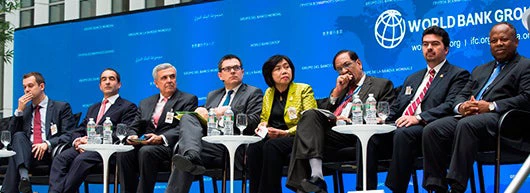
Our President – Jim Yong Kim opened the event which was moderated by Ed Crooks, US Industry and Energy Editor for the Financial Times. The panel included Dr. Ram Sharan Mahat, Finance Minister, Nepal; Leonardo Beltran, Deputy Secretary for Planning and Energy Transition, Mexico; Dr. Giulio Boccaletti, Global Managing Director for Water, The Nature Conservancy; Benedito Braga, President of the World Water Council; Wandee Khunchornyakong, Founder, Chairman & CEO, SPCG Public Company Limited – a Thai solar energy company; Alain Ebobisse of IFC’s Global InfraVentures and Michael Liebreich, Founder, Bloomberg New Energy Finance.
Energy for development
The key issue for the country representatives on the panel was the need for energy to drive development at the least cost. As Nepal’s Finance Minister, Dr. Mahat said: “Energy means more modernization, better social life, better education, and better life for common citizens”. And with hydro, wind, solar and geothermal energy now competitive with conventional fuels in terms of cost, the future for renewables in many developing countries looks very bright. Dr. Mahat said the time was now right for Nepal to tap its enormous hydro potential and Leonardo Beltran outlined Mexico’s ambitious energy reforms, including new national legislation for renewable energy. Through this law, Mexico has established medium and long-term binding targets including a target for one quarter of the country’s energy consumption to come from renewables by 2018. As Ed Crooks pointed out, that’s more ambitious than current European Union renewable energy goals.
Private sector investment with sound policy frameworks
Providing the big picture on global investment trends, Michael Liebreich noted that investment in clean energy had shrunk by 20 percent in the last two years, though three quarters of this was due to the dramatic reduction in the cost of renewable technologies. Even with investment trends now rising again, he said the world needs “to see something like a tripling (in investment) from where we are now if we are to see energy access and climate challenges being met.” But with more affordable technologies and demand increasing he said he is very “bullish” about the renewables sector returning to growth in the aftermath of the financial slowdown – and that’s for on-grid and off-grid energy.
We’re also bullish. Alongside record level World Bank investments of $3.6bn in renewable energy projects in fiscal year 2014, the IFC, our private sector arm is also driving hard on renewable investments— 10 years ago the IFC invested 22% of its energy portfolio in renewables, now it’s at least 67%. This reflects our policy priorities as well as market trends in which companies are finding a good business case to develop more climate-friendly energy projects.
From the Thai and solar perspectives, Wandee Khunchornyakong said countries need solid policy frameworks to have effective collaboration between the private sector and government. She said start-up companies like hers need access to appropriate financial mechanisms to fast track investment. After several unsuccessful attempts to get loans from banks in Thailand, she turned to the IFC. Now her company has established 36 small solar plants in Thailand which are generating power locally and the company is planning to expand into other ASEAN countries.
The role of hydropower
Hydropower is the world’s largest source of renewable energy and as demand grows for clean, reliable, affordable energy, along with the urgency of expanding access to reach the unserved, it has assumed critical importance. Of course hydropower does not come without risks but as President Kim said: “Managing risk does not mean doing nothing. Given the scale of the world’s unmet need for electricity, the mounting water scarcity in so many countries, and the climate threats we all face, we simply must support countries in safely developing their hydro power potential.” TNC’s Giulio Boccaletti said over the next 20-30 years, the world will build as much hydropower as it has in the past 110 years. “We’ve learned so much about how to build this infrastructure and how to plan this infrastructure better…we can steer that investment toward better outcomes”. He cited recent examples of river restoration in the US in which reducing the number of dams had improved the ecology and only slightly reduced hydropower capacity.
It was a great discussion and our panel showed that not only can we rise to the challenge, many countries and investors are already doing so - exciting times indeed. Now, after reading this brief summary and watching the event’s video, do you think the world can double the amount of renewable energy in the global mix by 2030? What do we need to do next? Join the conversation using the hashtag #endenergypoverty
Watch here: http://live.worldbank.org/rising-to-the-renewable-energy-challenge


Join the Conversation